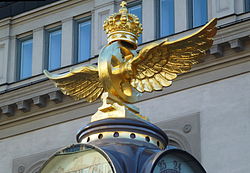Swedish State Railways
 From Wikipedia - Reading time: 6 min
From Wikipedia - Reading time: 6 min
This article relies largely or entirely on a single source. (June 2024) |
You can help expand this article with text translated from the corresponding article in Swedish. (April 2024) Click [show] for important translation instructions.
|
 | |
Native name | Statens Järnvägar |
|---|---|
| Company type | Government Agency |
| Founded | 1 June 1888 |
| Defunct | 1 January 2001 |
| Fate | Breakup in two phases |
| Successor | SJ AB (passenger trains) Green Cargo AB (freight trains) Banverket (infrastructure) Jernhusen AB (stations) |
| Headquarters | , |
Area served | Scandinavia |
| Products | Rail Transport |
| Owner | The State |


The Swedish State Railways (Swedish: Statens Järnvägar) or SJ, originally the Royal Railway Board (Swedish: Kungl. Järnvägsstyrelsen), was the former government agency responsible for operating the state-owned railways in Sweden.[1]
History
[edit]The Swedish State Railways was created on 1 June 1888[2] as an agency belonging to the Ministry for Civil Service Affairs, with the task of managing all state-owned railway lines in Sweden, and was transferred to the Ministry of Communications in 1920.
In 1988, the rail tracks themselves were transferred to the Swedish Rail Administration (Swedish: Banverket), and in the upcoming years parts of SJ were gradually transformed into limited companies as a result of the open access obligation introduced by EU Directive 91/440. SJ was disbanded in 2001, with the assets transferred to seven separate companies, the first three owned by the Swedish government and the latter four being privatized:
- SJ AB, usually called SJ, the passenger train operator
- Green Cargo, which operates freight trains
- Jernhusen, real estate
- EuroMaint, currently a part of CAF, train maintenance
- Unigrid, information technology
- TraffiCare, which provides terminal services, e.g. train cleaning and switching
- TrainTech Engineering, currently a part of SNC-Lavalin Rail & Transit, the technical unit.
Some of them have been sold to other companies, but SJ AB, Green Cargo and Jernhusen are still fully government owned (as of January 2025). Apart from these companies, Statens Järnvägar after 2001 continued to exist as a governmental agency, mainly dealing with the leasing of rail vehicles, but otherwise had no regular railroad activities. It was dismantled at the end of 2012 when that role was fully taken over by Trafikverket.
References
[edit]- ^ "Swedish State Railway". Swedentrains. Retrieved 2023-09-19.
- ^ Hans Högman. "Svenska järnvägens historia" (in Swedish). Hans Högman's website. Retrieved 9 December 2024.
External links
[edit]![]() Media related to Statens Järnvägar at Wikimedia Commons
Media related to Statens Järnvägar at Wikimedia Commons
 KSF
KSF